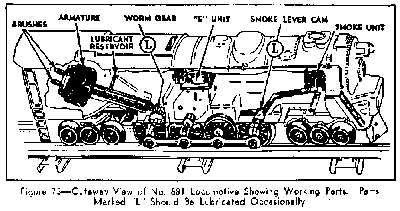
(Though the trains illustrated here are older models, the basic components and advice remain timely.)
While complete overhauling and replacement of parts is best done by an experienced repairman, you can do a great deal yourself to keep your trains in good operating order. The most important thing you can do is to clean and lubricate your equipment regularly.
A complete Lubricating and Maintenance Kit containing detailed instructions and necessary materials, is available at a good model railroad shop and is a good investment for a model railroader.

All parts of your train outfit which serve as electrical contacting surfaces must be kept clean and free of oil or grease which might act as an insulator. These parts are the rolling surfaces of locomotive and car wheels, the contact rollers and sliders and the track itself. Dampen a clean cloth with train cleaner or other household cleaner, run it over the surface to be cleaned, then wipe dry. If the rails or the rail pins have become rusted, good contacting surface should be restored by polishing with fine sandpaper or steel wool. Loose pins should be tightened with a pair of diagonal pliers. All missing pins should be replaced.
Frequently rails and pins become rust-coated during storage, particularly if they are kept in a damp place. A light coat of lubricant spread on the rails before they are stored away will keep them in good condition and free of rust and dirt.
If you have a smoke locomotive you may find that after some time the locomotive body may become covered with a whitish deposit of condensed smoke material. This coating is easily removed with a little Lionel Lubricant applied with a soft cloth.
To keep your outfit looking new you may want to clean the cars as well. The painted surfaces of car bodies should be cleaned with a cloth saturated with mild soap suds and dried carefully. Do not use any abrasive cleaners and solvents or you will destroy the printed car markings.
Like all fine mechanical equipment, O / O27 trains should be properly lubricated. This will guarantee good operation and prolong the life of your equipment. Proper lubrication does not mean excessive lubrication. Too much oil or grease is just as bad as none at all, because it will gather dust, foul the motor, and get on the wheels and track making them so slippery that the locomotive will not be able to pull the train. Lubricate thoroughly, but sparingly and wipe off all excess oil or grease.
A tube of special non-fluid Lubricant is furnished with each train cleaning outfit. Because this grease-type lubricant does not run, it should be used for all exposed moving parts of locomotives and cars. Such exposed parts, marked by letter L in the sketches on these pages, include gears, ends of pilot wheel axles, truck pivots and guides and axles of contact rollers and contact brackets. Pay particular attention to the exposed ends of armature shafts in locomotives equipped with transversely mounted motors, such as Nos.2035, 2036 and 2046. Because these shafts rotate at high rates of speed they require lubrication more frequently than any other part of the locomotive.
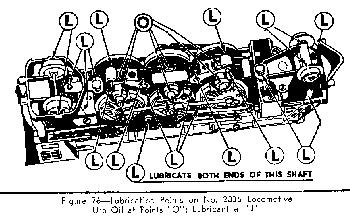
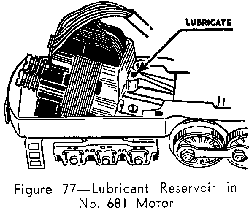
Locomotives where the motor is mounted lengthwise do not require as much attention since they are equipped with large lubricant reservoirs which are filled at the Factory. 1950 locomotives containing motors of this type are Nos. 681, 736, 2330 and 2343. Similar motors are used in such accessories as the 364 lumber and 397 coal loaders and 213 lift bridge. A motor equipped with a lubricant reservoir is illustrated in Figure 77. Figure 78 shows the lubricating points of the No. 681 locomotive, which is typical of those locomotives where the motor is mounted lengthwise.
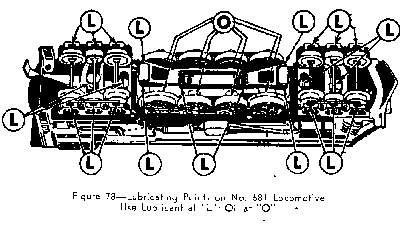
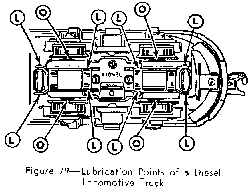
 |
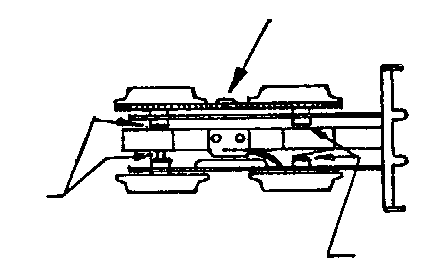 |
 |
The driving axles of Lionel locomotives run in porous bronze bushings which are impregnated with oil at the Factory and retain their self-lubricating properties for a long time. This self-con tained oil supply can be replenished with a few drops of light motor oil. Oil is also used to replenish oil wicks such as are used to lubricate the armature shafts in the whistle motor and in locomotives No. 622 and 2023.
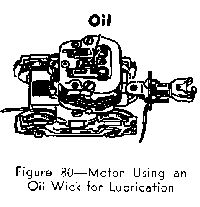
Figure 80 illustrates the type of motor using an oil wick for lubrication. In applying oil be careful not to get any into the brush wells which adjoin the oil hole. To avoid excessive use of oil, and to direct it only at the desired location, the oil should be applied a drop at a time, using a pin or a long wire as applicator.
The train whistle is located in the coal tender and call be reached by taking off the body of the tender. The whistle con sists of a relay, a whistle chamber, and the whistle motor. The motor is similar to other Lione motors and is cleaned in the same way, although the brush plate must be removed to reach the com mutator. The oil wick which lubricates the armature shaft of this motor is con tained in a long housing on top of the brush plate. The wick may be taken out, dipped in oil, and excess squeezed out.
Sluggish and uneven operation of the locomotive is most often caused by a dirty motor, A typical Lionel motor consists of parts illustrated in Figure 81. Although these parts may vary somewhat in shape and arrangement they can be easily recognized and are cleaned in the same way. The most important part to cleaned is the commutator, the segmented copper surface on which the carbon brushes make their contact. The commutator can be easily seen and reached for cleaning on locomotives having a transversely mounted motor. To polish the commutator face turn the locomotive on its side and connect one wire from transformer to the locomotive contact roller and the other wire to any metal part of the locomotive body. The motor will then run. While it is running press a small piece of very fine sandpaper against the moving commutator. Then clean out the commutator slots with an orange stick, toothpick, or similar pointed wood instrument.
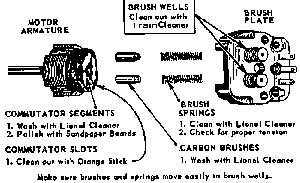
In locomotives where the motor is mounted lengthwise, the motor can be reached only after the locomotive body is removed. In many of them the commutator can be reached through a hole in the brush plate.
Improperly lubricated car trucks may double the drag on your locomotive. Spin the wheels by hand. If they show any signs of drag or binding remove the old lubricant and the accumulated dust and dirt with Lionel Cleaner and apply a dab of fresh lubricant at points A. If the truck is equipped with a contact roller, apply lubricant at the roller axles as well (Points B). Unless this is done the axles will eventually grind through the contact brackets.
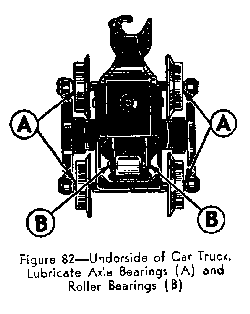
If the bulb in the locomotive headlights or in an illuminated accessory does not light, first check to see that the bulb is tight in its socket. If the lamp is burned out you can easily replace it yourself by obtaining a spare from your dealer. The chart on the inside of the back cover lists replacement lamps for all modern Lionel equipment.
To reach the head lamps of 1950 Lionel locomotives follow the directions below:
622 Remove cab by inserting a screwdriver in the slots on the bottom and turning them as indicated.
681 Pull out boiler front (Fig. 83A).
736 Open hinged boiler front
773 Open hinged boiler front
2023 Remove locomotive body.
2035 Pull out boiler front (Fig. 83A)
2036 Unscrew front truck bracket (Fig, 83B).
2046 Take out small screw in front of smokestack, then pull out boiler front.
2330 Lift out lamp bracket as shown in Fig. 83C
2343 Take off body by removing three screws.
2344 Take off body by removing three screws.
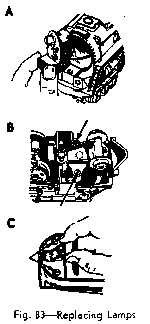
The remote control horns which are contained in Lionel Diesel and Electric Locomotives are powered by a flashlight dry cell which is inserted into the locomotive through an opening in its base. (See Figure 11). These cells will last a long time but eventually lose their power, even if they are not used.
These flashlight cells can be replaced by any standard size "L" cell, available in your hardware store, 5-and-l0-cent store, etc. If the locomotive is stored away for a long time its a good idea to remove the cell, for it will lose its power during storage in any case.
In 2330 Locomotive the dry cell is reached by removing end truck and lifting out floor panel. The panel is held by two screws shown by arrows in Figure 83C.
A short circuit is a direct connection between the two output terminals of the transformer or between the center rail and one of the outside rails. It causes an excessive-current to be drawn from the transformer so that the transformer circuit breaker keeps on opening and closing. The short circuit may be caused by a piece of metal or wire accidentally joining the center and the outside track rails, or by broken insulation between the center rail and the metal cross-ties.
If you have trouble in discovering the cause of a short circuit proceed as follows. Remove the train and all other equipment from the track and make sure that a piece of metal or Christmas tree tinsel is not touching the rails. See that all sections of track fit tightly. Then connect one wire from transformer to an outside rail and brush the end of the other transformer wire across the center rail, If the track is perfectly insulated no sparking will occur at the place where the wire touches the rail, but if it is short-circuited, sparks will appear.
To locate the short-circuited section, disconnect one section of track at a time and apply the wires to the remaining sections as explained above. When the defective section is removed, the sparking will stop.
If your train refuses to run, first make sure that the transformer is plugged in and that you are getting current from the transformer output terminals. Then see that all connections on transformers and track are correct and firmly fastened. See that there are three steel pins inserted at the end of each section of track.
If train still runs, disconnect the two transformer wires from track. Prop locomotive right side up so that wheels are free to turn. Touch one of these. wires to any unpainted part of the motor frame. With the other wire touch the contact shoe which collects the current from the center rail of the track. If motor still does not operate, it may be that the reversing unit is in neutral position. If the E-Unit is in neutral position, the locomotive will not run, although the locomotive headlights will be on. Try the above procedure with different adjustments of the reversing unit lever.
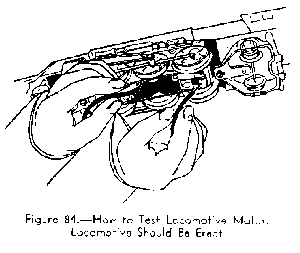
If the wheels move very slowly, cleaning and lubricating the motor may be all that is necessary to restore original power.
If motor starts and stops, or if wheels do not revolve, look for loose connections. See if the carbon brushes make good contact with commutator, clean the commutator as described in a previous section.
If the wheels revolve freely there is nothing wrong with the locomotive motor. The trouble may be that the contact shoe rollers do not have enough tension to make proper contact with the center rail. If contact rollers appear to be badly worn, have them replaced at the nearest hobby shop which repairs trains.